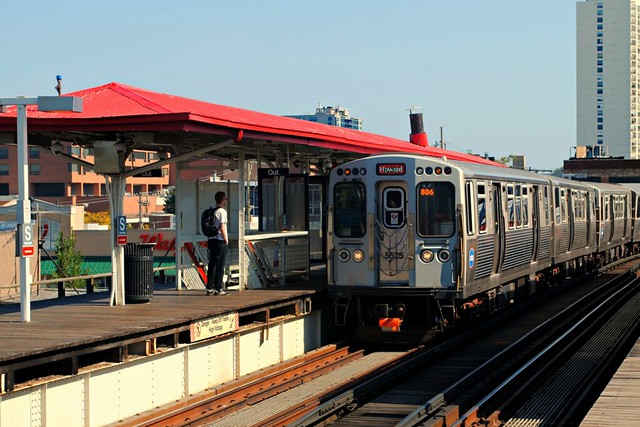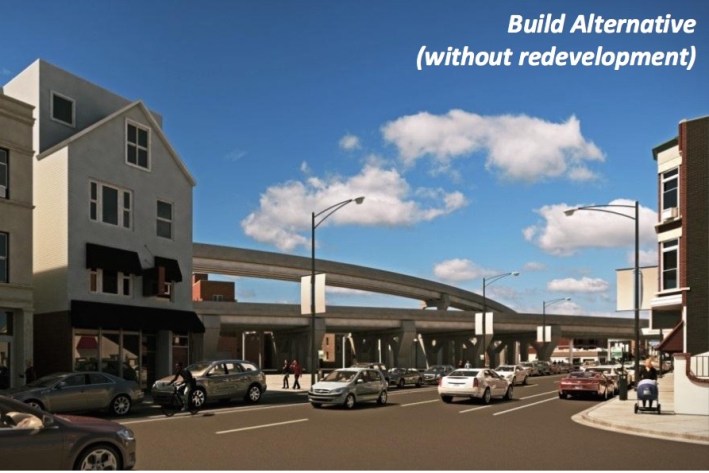
The first phase of the Red and Purple Modernization Program – including the hotly contested plan for the Belmont flyover – took a step closer to becoming a reality yesterday. Officials announced that $281 million in federal funding has been earmarked for the initiative, which also includes rebuilding the track structures, viaducts, and stations between Lawrence and Bryn Mawr. That’s nearly 30 percent of the $956.6 million in federal funding the CTA is seeking for Phase 1, now estimated to cost $2.131 billion.
Mayor Rahm Emanuel, U.S. Senator Dick Durbin and CTA president Dorval Carter, Jr. announced that Barack Obama’s proposed federal fiscal 2017 budget includes $125 million of funding in 2017 for RPM Phase 1. The money would come from the Federal Transit Administration’s Core Capacity Improvements program, which provides dollars for improvements to older "legacy" transit systems. This news isn’t a surprise, because last September the Chicago Metropolitan Agency for Planning approved the project for the FTA funding.
Also announced on Tuesday, the U.S. Department of Transportation has allocated a separate $156 million in new funding provided by Congress for Phase 1. This money had been budgeted for in previous years but never appropriated. The CTA is currently seeking approval of a full-funding agreement from the USDOT. If this is OKed, the transit agency will get the $156 million.
Back in 2014, the CTA received a $35 million Core Capacity grant, which allowed the agency to complete the preliminary planning and engineering work for Phase 1 last year. In December, the modernization project passed its environmental review by the FTA, allowing the project to move on to its engineering phase, which would be followed by construction. Last month CTA officials said the rehab work on the nearly 100-year old train lines could start as early as late 2017.
But it’s important to keep in mind that the announced $125 million in Core Capacity funding isn’t a sure thing, since Obama’s budget is merely a proposal right now. And, of course, there’s a heck of a lot more federal and local money that needs to be found before construction can begin.
The CTA’s next steps for the project include finalizing the funding plan for Phase 1, applying for more federal funding, and selecting a contractor to design and build the project. The local funding would come from a mix of state and city sources.
One possibility for this local funding would be the establishment of a transit-oriented tax-increment financing district around the RPM project site. The TIF would capture the property value and tax revenue increase generated by the improved transit service and earmark it to pay for the construction. Last May the Illinois Senate passed legislation that would enable this strategy, although it’s currently stalled in the House’s rules committee.
Another big hurdle for the project is political opposition. The Belmont flyover, officially called the Red-Purple Bypass, would eliminate the logjam north of the Belmont station, where Red and Purple trains are forced to wait while northbound Brown Line trains cross their tracks at the same level. The CTA says that building the overpass for the Brown trains would allow the agency to run up to eight more Red Line trains, carrying 32 percent (7,200) more riders per hour during rush periods.
That would go a long way towards addressing the current sardine-like conditions on the Red Line during peak hours, not to mention future ridership demand. Ridership along the Red Line corridor grew by 40 percent between 2010 and 2014, and the population of the corridor is projected to grow by at least 25 percent over the next two decades.

However, the perks of building the flyover would come with a price – 16 buildings would need to be demolished to make room for the structure. Understandably, many Central Lakeview residents are fiercely opposed to the project. In a November 2014 ballot referendum involving the three 44th Ward precincts that would be most heavily impacted, 72 percent of the roughly 800 voters were against building the flyover.
There’s one development that offers some reassurance the bypass project wouldn’t permanently gut the neighborhood. Last fall the CTA learned it would receive $1.25 million in funding through FTA’s Transit-Oriented Development Pilot Planning Program.
This year the transit agency will use the funding to hire a consultant to work with local residents and elected officials to create transit-oriented development plans for the area affected by the flyover, as well as the Lawrence-to-Bryn Mawr corridor. “The CTA intends to move forward with its promise to encourage redevelopment,” states a news release on the new RPM funding.
![]()
Did you appreciate this post? Streetsblog Chicago is currently funded until April 2016. Consider making a donation through our PublicGood site to help ensure we can continue to publish next year.




